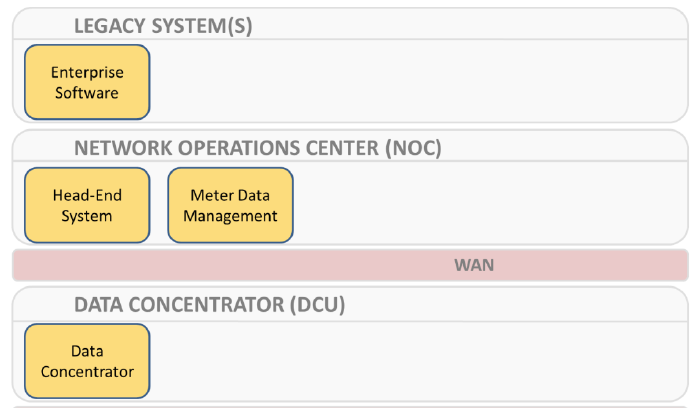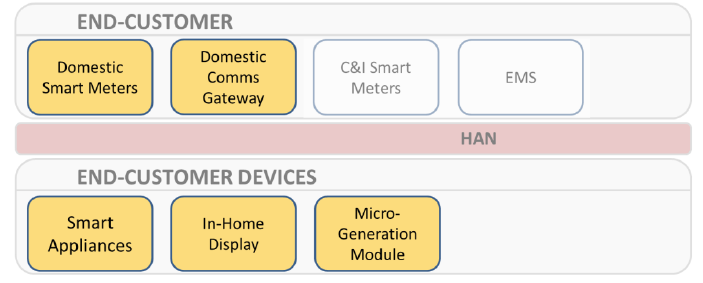This article is about components of Advanced Metering Infrastructure Components are Meter Data Management, Data Concentrator, Energy Management System, End-Customer Devices Layer, Micro-Generation Module, Data Concentrator.
Advanced Metering Infrastructure Components
The desired functions for the AMI (§3) and the Application (§4.1) and Communications Layers (§4.2) to facilitate such functionality (all bound within the System Architecture outlined in Figure 1 and Figure 2) have already been described. This section lists a set of physical components of Advance Metering Infrastructure that will be required to fully implement the AMI functionality described.
Each component to Advanced Metering Infrastructure is introduced with respect to its associated Applications Layer as follows:
1. End-Customer Devices Layer
1.1 Smart Appliance
A device within the home or business that can be monitored and controlled from the AMI, via a Smart Meter and using a local network, e.g., Smart Thermostats for HVAC systems.
1.2 In Home Display (IHD)
A device within the home/business that can be used by the End-Customer as an interface to the AMI, from where they can co-ordinate control of Smart Appliances.
1.3 Micro-Generation Module
A device within the home/business that is used to supplement their energy supply, e.g., a rooftop-mounted PV panel or micro-CHP unit. These are made distinct from Smart Appliances within the sense of the AMI, as the Utility may wish to apply more stringent regulations regarding their connection than the unregulated manner in which loads are connected.
2. End-Customer Layer
2.1 Domestic Smart Meter
These devices are the main means by which metered data is obtained from the home and through which control actions can be sent to Smart Appliances. A distinction is made between the Master End Customer Meter (MECM) and other sub-metering devices within the home. The MECM will likely have more complex functionality than any sub-metering applications.
2.2 Commercial and Industrial (C & I) Smart Meter
The distinction is made between Domestic Smart Meters and C & I Smart meters here because the requirements are likely to change according to the type of application that the Smart Meter is placed in.
One might expect that more stringent accuracy requirements are needed for measurements obtained from C & I meters, a greater range of environmental performance factors may be considered for C & I applications and a wider range of measurements may be required (Power Quality, etc.).
As per §1.1, the specification of C&I meters falls outside the scope of this article. Further requirements for this particular aspect of the AMI shall not be presented here.
2.3 Energy Management System (EMS)
In some circumstances, for large C & I buildings, the AMI may interface with an EMS, which may by itself already be presiding over the control of “mini-AMI” within the building, encompassing items such as sub-metering equipment and device controllers. In such circumstances it makes sense for the AMI to interface directly with the existing system rather than the sub-components of that system, to access information such as meter readings and device operation schedules.
As per §1.1, specifying EMS falls outside the scope of this article. Further requirements for this particular aspect of the AMI shall not be presented here.
2.4 Communications Gateway
This device facilitates functions such as protocol conversion that allow the MECM to communicate with elements in the HAN.
3. Data Concentrator Layer
This layer is optional according to whether Solution A or B for the AMI implementation is specified at the design stage.
Data Concentrator (DCU)
This device will be used within large AMI implementations as an intermediate buffer stage between the End-Customer and the Network Operation Center. Its presence makes the AMI solution more scalable.
4. Network Operation Center Layer
This layer represents the central location within which all metered data is ultimately aggregated and from which all high-level commands are issued to the rest of the AMI. It incorporates all back-end sub-systems and analytical functionality of the AMI.
4.1 Head-End System (HES)
The potential use of different metering vendors within one integrated AMI system may require different types of Smart Meters, DCUs and HES to be installed as separate metering systems within the same implementation. Such systems must operate in parallel and be inter-operable with the single MDM instance. One will be applied HES per metering system.
4.2 Meter Data Management (MDM)
The role of the MDM is to analyze meter data (and offer other supplementary functions such as trend identification) to provide SCADA with the only most pertinent information through which control actions can be informed and automated.
Metered data received from the field will also be validated for errors at this stage of the AMI. In addition to metered data, many MDMs are also able to process Alarms and Events from within the AMI. All of this functionality should be able to be performed very quickly.
The MDM should have a Data Historian feature, allowing it to provide long-term storage for all metered data it receives, be time-synchronized to a reliable source (GPS) and so ensure that each piece of data received is time-stamped with respect to the location at which it was taken.
5. Component Map
For reference, Figure 5 maps the Components of the AMI, as listed above, to the relevant Applications Layer (defined in §4.1). Detailed specifications for C&I meters and EMS modules are not presented in this document.


Here we discussed above components of Advanced Metering Infrastructure Components are Meter Data Management, Data Concentrator, Energy Management System.